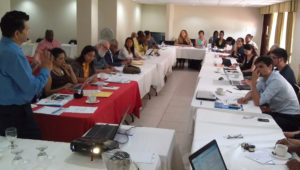Caribbean SEED (STEM Engine for Economic Development) Summit
“Harnessing STEM for Economic Development”
Key Dates
- Due date for abstract of contributed papers: 31 March 2026, 11:59 pm AST
- Due date for executive summaries of business plans: 31 March 2026, 11:59 pm AST
- Notification of acceptance of contributed papers and executive summaries: 15 April 2026, 11:59 pm AST
- Due date for fully written papers and PowerPoint slides of business plans: 21 June 2026, 11:59 pm AST
- Registration deadline for active observers only: 25 June 2026, 11:59 pm AST
- Events of the 2026 Caribbean SEED Summit: 26-28 June 2026
1. Introduction
The Caribbean SEED (STEM Engine for Economic Development) Summit is an information-sharing, collaboration and brainstorming platform that brings together Science, Technology, Engineering and Mathematics (STEM) researchers from academia and industry, entrepreneurs, investors, product development experts, students, educators, government officials, policymakers, and other leaders and experts from the Region and the Diaspora to stimulate technology company formation.
The Caribbean Science Foundation (CSF) is working cooperatively with the Barbados Ministry of Industry, Innovation, Science and Technology (MIIST) to launch and execute the inaugural SEED Summit, but the Summit will evolve to be a joint initiative of several Caribbean entities. The inaugural SEED Summit will be held in a hybrid mode with some in-person events in Barbados, but all events will be available for virtual participation on the Zoom platform. The Summit dates are tentatively set for 26-28 June 2026.
The Summit bridges the wide gap between STEM education and economic development in the Caribbean. The events of the Summit will feature high-impact technology research and development presentations, networking opportunities, and the exchange of technical and business information, along with a business-pitching session for entrepreneurs and invited funding agencies. It will serve as a catalyst to provide a pathway for STEM talent and entrepreneurship to come together with funding sources for new company formation.
The SEED Summit is expected to serve as a premier annual gathering event for Caribbean nationals and global collaborators who are leading groundbreaking research, pursuing real-world applications of STEM, financing STEM companies, and engaging in STEM education reform. By creating a recurring platform for knowledge exchange for entrepreneurial growth, the Summit will help to build a vibrant, self-sustaining STEM community that will drive Caribbean economic development.
2. Why the Caribbean SEED Summit: Regional Economic Challenges
Global challenges such as energy security, food security, climate change, and natural threats continue to impede economic development in the Region. Also, high levels of debt and unemployment and the continued heavy reliance on traditional sectors for growth expose our economies to significant risks. For example, the Central Bank of Barbados had projected a real GDP economic growth of 2.7% for 2025 that is driven by tourism, construction and business services. Contributions from STEM-driven businesses were not explicitly identified as a significant factor in the projected growth. Further, support for STEM entrepreneurship and innovation is limited, and the skills necessary to harness the emerging technologies are lacking in the local workforce.
To advance our economies and mitigate the risks from global instability, new avenues for job creation, entrepreneurship and foreign investment need to be explored. One such avenue is seizing opportunities in STEM which can allow our countries to take full advantage of the potential to build a modern-day workforce and to diversify their economies through the development of STEM-based economic pillars.
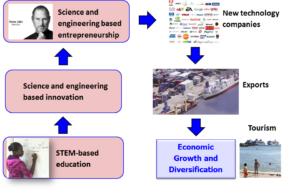
This means that the Region must accelerate education reform to: (a) increase the level of interest in the sciences, (b) encourage more youth to pursue careers in science and engineering, and (c) promote more awareness in teachers and in the general population of the link between science and engineering, and economic development (Fig. 1).
The SEED Summit is a vehicle that will help address the STEM workforce challenge along with the challenges of low investment in STEM-based and STEM-enabled businesses. Its long-term desired outcomes are the significant development of globally competitive companies that: (a) produce goods and services based on new technologies, (b) apply new applications of existing technology, and (c) are technology-enhanced entrepreneurial enterprises, thereby significantly increasing the contribution to the GDP from STEM.
2.1 SEED Approach to Small Business Formation
Caribbean nationals hold prominent STEM and STEM-related positions in the Region and the Diaspora, and there is a strong Caribbean STEM talent pool in all age groups in the Region and the Diaspora. To leverage this experience and expertise for driving small business creation in the Caribbean, one approach is to follow the CSF’s technology company creation model for the Caribbean as depicted in Fig. 2.
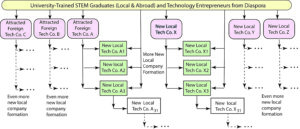
The model shows that we must attract both foreign STEM-Based companies (left half) and build home-grown companies (right half) to be successful. This would involve inviting STEM graduates abroad who want to come back to the Region, and technology entrepreneurs from the Diaspora who have an interest in working or setting up companies in the Region to join us. Incentives would have to be put in place to make it very attractive for both the foreign STEM-based companies to come to the Region, and the invited Caribbean STEM professionals and technology entrepreneurs to set up home-grown businesses or branches of their businesses in the Region.
The model shows how exponential growth of new companies will be fueled by employees of some of these early companies leaving the parent companies to set up new enterprises. The SEED Summit aims to be the catalyst that ignites this process.
2.2 The SBIRD Model: Stimulating Investment in Start-ups and Early-stage Companies
Caribbean government and investor involvement in the Summit is critical, as government investment into startup and early-stage companies is a major expected outcome of the SEED Summit. Therefore, in parallel with the annual Summit, the CSF urges Caribbean governments to set up programs such as the Small Business Innovative Research Development (SBIRD) program (described below and in Ref. 1 and illustrated in Fig. 3). The SBIRD program would run throughout the year and be focused on the funding of technology-based companies resulting from the SEED Summit.
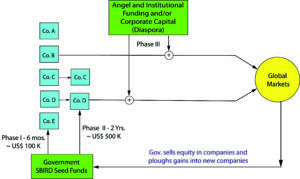
The SBIRD model is a funding vehicle that consolidates government-sponsored science and engineering research funds and provides grants to new and early-stage STEM enterprises in two phases (shown by example in Fig. 3) based on strict eligibility criteria. In Phase I, the government provides seed and early-stage (ignition) capital to small technology businesses (e.g., less than 100 employees) on a competitive basis to establish feasibility of a product or service.
Between 6 to 12 months later, Phase I awardees that successfully meet the technical feasibility milestones are invited to submit new Phase II proposals (business plans) for possible two-year funding to develop pre-manufactured prototypes of almost-market-ready products and services. The government may opt to take a small equity interest in the company for its Phase II investment. The goal of the Phase II funding is to help bring the most promising companies to a stage where they are more attractive to institutional investment. The government should follow up and assist with mentorship of the Phase II entrepreneurs and company leaders.
Phase III would be the full commercialization phase, where the funding would come from angel and institutional investors. Of course, the goal of the institutional investment is to propel as many of these companies as possible to the globally competitive stage. After the companies are successful, the government should sell its interest in the companies and re-invest the gains back into the SBIRD seed program for injection into new startups as illustrated in Fig. 3.
The CSF will assist governments with the proposal evaluation process, reviewing the performance and progress of the projects, evaluating the final reports and helping the most successful companies find Phase III funding from angel investors, and venture and corporate capital.
3. Seizing a Unique Opportunity to Recruit STEM Talent
Based on the work of the CSF in the Diaspora (see Caribbean Diaspora for Science Technology and Innovation) we have observed that there are many Caribbean STEM professionals and terminal-degree students (at the Masters and Ph.D. level) in the Diaspora and the Region who are conducting cutting-edge research across multiple key areas of science and engineering. Many of them are helping to increase the GDP of the countries in which they reside, and a substantial fraction of them would like to contribute to the Caribbean. Most importantly, many of them are interested in technology entrepreneurship and would join or create startups in the Region if the opportunities to do so were present.
One subset of this larger group is the students who graduated from the CSF’s SPISE (Student Program for Innovation in Science and Engineering- see https://caribbeanscience.org/SPISE). Over the past 14 years, several Caribbean organizations and high-net-worth individuals have invested collectively about US$ 1.8M in advancing the STEM aspirations of 265 SPISE scholars. In their application forms to SPISE, these students had all pledged to give back to the Caribbean at some appropriate time in their lives.
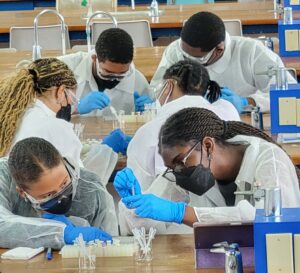 Thirty-two of these students have attended or are attending MIT (the premier science and engineering university in the world) and many others have graduated from universities such as Stanford, Princeton, Columbia, Harvard, Dartmouth, U Penn, Georgia Tech, University of Rochester, University of Toronto, McGill, McMaster Univ., Univ. College London, Imperial College, and UWI. Further, several SPISE graduates have or are now pursuing advanced degrees in STEM at the M.S. and Ph.D. levels at MIT, Stanford, Harvard, Johns Hopkins University, Yale, Princeton, Dartmouth, Carnegie Mellon, University of Washington and University of Pittsburgh. We believe that the SEED Summit could represent a first step towards not only mobilizing the scientific Diaspora for the benefit of the Region, but also providing an opportunity to capitalize on the above investments made in our youth.
Thirty-two of these students have attended or are attending MIT (the premier science and engineering university in the world) and many others have graduated from universities such as Stanford, Princeton, Columbia, Harvard, Dartmouth, U Penn, Georgia Tech, University of Rochester, University of Toronto, McGill, McMaster Univ., Univ. College London, Imperial College, and UWI. Further, several SPISE graduates have or are now pursuing advanced degrees in STEM at the M.S. and Ph.D. levels at MIT, Stanford, Harvard, Johns Hopkins University, Yale, Princeton, Dartmouth, Carnegie Mellon, University of Washington and University of Pittsburgh. We believe that the SEED Summit could represent a first step towards not only mobilizing the scientific Diaspora for the benefit of the Region, but also providing an opportunity to capitalize on the above investments made in our youth.
With the SEED Summit placing a strong emphasis on youth engagement, entrepreneurship, and interdisciplinary problem-solving, and with the Region facing a STEM deficit, the summit will be an important step in the process of STEM education reform.
Whether you are a student exploring STEM careers, a researcher seeking collaborators, an entrepreneur with a bold idea, an investor looking for technology-based companies in the Caribbean to support, or a policymaker invested in sustainable development, this summit is your opportunity to connect, learn, and contribute to the STEM revolution of the Caribbean.
4. Targeted Areas of Interest
The events of the SEED Summit will cover many of the critical STEM disciplines that align with the Caribbean’s development needs, such as:
- Fundamental Sciences – Mathematics, Biology, Chemistry, and Physics
- Agriculture & Food Science – sustainable farming, food security, and agri-tech innovation
- Renewable Resilience and Renewable Energy
- Mechanical, Electrical, Chemical, Aerospace, Biological, and Environmental Engineering
- Computer Science – Software Engineering, Artificial Intelligence, Data Science and Machine Learning, cybersecurity, digital transformation
- STEM Education Reform – innovative teaching methods and policies to strengthen regional STEM capacity
- Business & Entrepreneurship – commercializing research, start-up ecosystems, and tech-driven economic growth
5. Events of the SEED Summit
The events of the Summit will include:
- Keynote Presentations and Vision Talks – Leading Caribbean and international STEM and business experts will share insights on ground-breaking research, industry trends, and career pathways. Forward-thinking presentations that explore grand challenges, futuristic technologies, or strategic opportunities for the Caribbean in the global economy will be included. These talks will inspire and provoke bold ideas for action.
- STEM Research Presentations – Original scientific research that advance understanding and highlight future directions in a STEM field will be presented. Topics will span the targeted areas listed above. Persons interested in presenting must submit an abstract and a paper (see Sec. 7). Authors of accepted papers will be given an opportunity to present their papers during the Summit.
- Panel Discussions – These are Interactive sessions by invited speakers on pressing regional challenges, featuring diverse voices from academia, industry, and government.
- Entrepreneurship & Investment Opportunities – A STEM Start-up Challenge (Shark-tank style) pitch competition will be conducted to allow Caribbean researchers, startups and early-stage companies to present their ideas to investors and funding agencies. As part of this event, the Government of Barbados will host the Barbados STEM Startup Challenge which will be open to all STEM entrepreneurs in the Region and abroad who are interested in launching their companies in Barbados (See Sec. 8 and 9).
- STEM Talent Recruitment Opportunities for Corporations Seeking Employees – Such opportunities will be offered to regional companies that support the SEED Summit. To support the Summit and ensure its long-term sustainability, corporations, NGOs and individuals may contact Prof. Cardinal Warde at warde.csf@gmail.com.
In all the events of the SEED Summit, there will be real-time Q&A and networking activities where attendees will have opportunities to engage directly with speakers, mentors, and potential collaborators. At the conclusion of the Summit, the CSF will prepare and publish the contributed papers in the Caribbean STEM Journal (see details below) and update its Database of Caribbean STEM Professionals.
6. How to Participate in the SEED Summit
Persons may participate as:
- Presenters of contributed research papers (see Sec. 7)
- Entrepreneurs presenting/pitching a business plan (see Sec. 9)
- Investors and funding agencies in the STEM Startup Challenge
- Invited Keynote Speakers
- Government officials
- Active Observers (e.g., high school students, most university students, most teachers and parents)
Please note that the events of the Summit will be open to all high schools in the Region and will be streamed worldwide, making it a far-reaching educational experience.
The registration form has two Sections. All persons wishing to participate (on-line and in-person) in the SEED Summit must submit Section 1 of the Registration Form (link below). Section 1 contains biographic information only. By filling out Section 1 now, you will automatically: (a) be Zoom registered as an on-line participant for the events of the Summit, and (b) qualify for in-person access to the Summit venue in Barbados. If you are going to participate as an active observer, you need fill out Section 1 only.
Section 2 is required for persons offering to give contributed papers and talks and/or to present/pitch a business plan. Section 2 requests either a recent biographic sketch, CV or resume, and either an abstract of your paper if your are offering to present a paper, or an executive summary if you are offering to pitch your business plan (or both in some cases).
The link to the SEED Summit Registration Form can be found HERE.
The Zoom link for on-line participation in all SEED Summit events will be shared with all registered individuals at least one week before the start of the SEED Summit events.
If you are considering submitting a paper and giving an oral presentation of your paper, you can begin working on your abstract now. Similarly, if you want to pitch your business plan for the STEM Startup Challenge, you can begin working on your executive summary now. Please note that not all papers and business plans will be accepted, as they are some minimum requirements that must be met (see Secs. 7 and 9). Note that details about the submission of papers and business plans will be shared directly, after the CSF receives the completed registration/application form. As a reminder, the key dates for the events of the 2026 Summit are:
- Due date for abstract of contributed papers: 31 March 2026, 11:59 pm AST
- Due date for executive summaries of business plans: 31 March 2026, 11:59 pm AST
- Notification of acceptance of contributed papers and executive summaries: 15 April 2026, 11:59 pm AST
- Due date for fully written papers and PowerPoint slides of business plans: 21 June 2026, 11:59 pm AST
- Registration deadline for active observers only: 25 June 2026, 11:59 pm AST
- Events of the 2026 Caribbean SEED Summit: 26-28 June 2026
Please note that notification of acceptance of contributed papers and executive summaries as well as details about the submission of full papers and slides will be shared directly by 15 April 2026.
7. Information for Persons Contributing Papers
Call for Contributed Papers
During the SEED Summit, a roster of about 10 – 15 persons contributing papers (not including the entrepreneurs pitching their business plans) will be presenting in multiple sessions ensuring diverse perspectives and comprehensive coverage of topics. The Summit welcomes contributed papers from persons who are working on STEM-related research projects or initiatives that directly impact or involve the Caribbean region, in the targeted areas of interest (see Sec. 4). Contributed papers are defined as those that follow the guidelines below and are submitted with the aim of being presented during the Summit.
Presenters of contributed papers represent a wide range of individuals committed to STEM advancement in the Caribbean. These may include:
- Outstanding Diaspora and regional STEM professionals, researchers and academicians with ongoing or potential collaborations in STEM fields in the Caribbean
- Outstanding University students pursuing STEM pathways, and in particular certain graduates from the CSF’s SPISE Program
- Ministries of Education, Ministries of Science & Technology, and regional policy makers
- STEM educators and education reform advocates
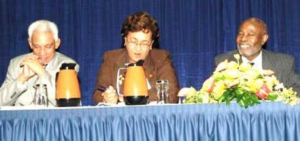 All presenters must be able to demonstrate a strong ethnic, professional, business or academic association with the Caribbean region. Submissions of papers for presentation must be directly relevant to the Caribbean—whether through the focus of the research, its intended impact, or its implementation within the Region. That is, the authors must explicitly explain how their work is linked to the Caribbean development objectives. This ensures that the SEED Summit remains rooted in regional advancement while highlighting the contributions of Caribbean nationals and allies committed to STEM development across the Region.
All presenters must be able to demonstrate a strong ethnic, professional, business or academic association with the Caribbean region. Submissions of papers for presentation must be directly relevant to the Caribbean—whether through the focus of the research, its intended impact, or its implementation within the Region. That is, the authors must explicitly explain how their work is linked to the Caribbean development objectives. This ensures that the SEED Summit remains rooted in regional advancement while highlighting the contributions of Caribbean nationals and allies committed to STEM development across the Region.
Presenters of contributed papers are required to:
- First submit an abstract which will be reviewed by a panel of experts.
- Once an abstract is reviewed and accepted, the primary author will be contacted with further instructions to submit a full paper for presentation at the SEED Summit.
- Make an oral presentation of their paper
Abstract, Paper and Oral Presentation Guidelines
Abstracts must be submitted via the registration form. Notification of acceptance of contributed papers as well as details about the submission of full papers and slides will be shared with the authors by 15 April 2026. To maintain a high standard of quality and consistency across presentations, the following formatting and submission guidelines are provided below:
Abstract:
- Title of the submission
- Category of the research paper (see Sec 4. – Targeted Areas of Interest)
- Author(s) or Presenter(s) with affiliations, including presenting author (indicated by * and a footnote)
- A 150–300-word summary outlining the core idea, relevance to the Caribbean, and expected impact
Paper:
- Format: An “Overleaf” template (using Latex) will be made available.
- Length: 3–10 pages (including embedded figures and references)
- Font Size: Minimum 10 pt
- Spacing: Single-spaced
- Quality: Papers must be fully edited, camera-ready, and properly cited. Submissions should be written in clear, professional English and provide sufficient context for interdisciplinary understanding.
Oral Presentation:
Authors whose papers are accepted for publication, and all other invited speakers must make oral presentations of their work, subject to the following guidelines:
- Duration: 15 minutes maximum, inclusive of Q&A
- Slides: Must be submitted at least 2 days in advance of the talk and presentation-ready (clean, clear, and visually accessible)
- Format: PowerPoint (Standard 4:3 aspect ratio)
- Language: Presentations must be delivered in English
Evaluation Criteria for the Papers:
All submissions will be evaluated by a panel of experts based on four key criteria to ensure alignment with the Summit’s goals:
- Novelty of the work will be assessed to determine the originality and innovation of the research or idea presented
- Technical feasibility must be demonstrated through literature support or original data
- Strong relevance to the Caribbean, whether through the work’s focus, application, or potential impact on regional development
- Commercial potential with significant promise for scalability and real-world application, not only in the Caribbean but also globally
8. STEM Startup Challenge and Pitches by Entrepreneurs
The STEM Startup Challenge will be open to all STEM entrepreneurs, STEM Startups, and early-stage companies in the Region and abroad who are interested in launching their companies or initiating their projects in the Caribbean. This is a forum where creative ideas for company formation and investment commitments or opportunities come together to propel new or early-stage companies. The Startup Challenge begins with entrepreneurs submitting an executive summary to the CSF for consideration (see below – Information for Entrepreneurs Desiring to Pitch a Business Plan).
Using criteria such as technical merit, market size, niche in the competitive landscape, and potential for addressing global markets, a set of CSF judges will short list the most promising startups as finalists. The chosen finalists then present their ideas live to a panel of investors, industry leaders and key stakeholders at the SEED Summit. Winners could be eligible for funding, mentorship and/or incubation support. Table 1 is a numerical example of how a Caribbean government could get its SBIRD program started via its participation in the Summit.
| Amount | ||||
| TOTAL Investments = US$ 10M | ||||
STEM Startup Challenge
It is important to note that the Government of Barbados has expressed its intent to participate in the STEM Startup Challenge in 2026.
9. Information for Entrepreneurs Desiring to Pitch a Business Plan
As a part of the STEM Startup Challenge, entrepreneurs, startups and early-stage companies are invited to submit an executive summary of their business plan as detailed below. Entities whose executive summaries are shortlisted will have the opportunity to pitch their business plans live to a panel of investors, industry leaders and key stakeholders at the SEED Summit. Winners could be eligible for funding, mentorship or incubation support under the STEM Startup Challenge program (described above).
Executive Summary Guidelines
Executive summaries must be submitted via the registration form. The executive summaries will be treated as confidential information and will shared only with the CSF administrative staff, the selection committee, and the relevant potential investors. Note notification of acceptance of executive summaries as well as details about the submission of slides will be shared directly by 15 April 2026.
To maintain a high standard of quality and consistency across presentations, the following formatting and submission guidelines have been developed:
Format:
- Length: 3 pages maximum (including embedded figures and references)
- Font Size: Minimum 10 pt
- Spacing: Single-spaced
- Name of business or project
- Description of business or project
- Category of the problem the business/project seeks to solve/its niche (see Sec. 4 –Targeted Areas of Interest)
- Relevance of business to the Caribbean, and its expected impact
- Product/service market size
- Competitive advantage
- Funding request/amount of investment being requested
- Owner(s) of the business with the person(s) making the pitch indicated by * and a footnote
Business Plan Pitch Guidelines
Entrepreneurs whose executive summaries are shortlisted are subject to the following guidelines when making their business pitch:
- Duration: 20 minutes maximum, inclusive of Q&A
- Slides: PowerPoint (Standard 4:3 aspect ratio) preferred, and must be presentation-ready (clean, clear, and visually accessible)
- Language: Presentations must be delivered in English
- A copy of your slide deck must be submitted to the CSF no later than 21 June 2026. The slide deck will be treated as confidential information and will shared only with the CSF administrative staff and the relevant potential investors.
10. The Caribbean STEM Journal
The Caribbean STEM Journal will be the official Journal of the SEED Summit. It will be produced in digital form after the conclusion of the Summit and will provide a comprehensive record of the event with insights, outcomes and future pathways identified. The content will cover topics such as:
- Organizers’ message and SEED Summit vision and goals
- Thematic areas of focus
- Speaker and panel profiles and highlights, industry insights and notable quotes and recap of panel debates, emerging trends and action points
- Abstracts and full papers
- Small Business Innovative Research Development (SBIRD) Program summary
- Feasibility grants awarded, description and criteria
- STEM Startup Challenge participant profiles, winning ideas and awarded projects, investment commitments and opportunities
- SEED Summit outcomes, feedback (post-event survey) and key takeaways, post-Summit actions
- Potential industry collaborations, research initiatives and government support
- Case studies and success stories
- Recommendations for strengthening STEM in the Caribbean and investment opportunities in education, innovation and startups
- Reflections and future vision
11. Benefits and Expected Results
The SEED Summit provides substantial value not just to individuals, but to the entire Caribbean. As such, it will:
- Strengthen regional innovation ecosystems by fostering research collaborations and startup incubation.
- Produce economic diversification and growth by nurturing a culture of innovation and supporting tech-based startups, thereby contributing to the diversification of Caribbean economies.
- Enhance educational reform by promoting modern, project-based STEM education that aligns with the 21st-century.
- Inspire and empower our youth by informing and motivating the Region’s next generation of scientists and engineers through highlighting the achievements of Caribbean STEM professionals and exposure to real-world applications.
- Ignite regional integration by uniting voices and actions from across the Caribbean and the Diaspora, fostering a collaborative approach to our shared challenges.
- Assist with workforce development by encouraging skill-building in areas that are critical for future employment and competitiveness in a global economy.
- Create new job connections by giving our underemployed or unemployed STEM university students the opportunity to build new relationships with established STEM professionals and experts, and funding agencies so they can put their skills to work.
- Inform policy makers by providing and stimulating discourse on how STEM can be employed to enhance regional economic development.
- Foster collaboration and networking between STEM and business professionals resulting in funding agencies meeting with teams that will build new companies or enhance the growth and performance of existing companies.
- Provide access for local and regional companies to more highly qualified STEM talent by facilitating connections that will result in recruiting consultants and hiring new STEM employees.
- Stimulate more investments by Governments of the Region into technology companies that appear to have the highest probability for commercial success, using the Small Business Innovative Research Development (SBIRD) model or similar.
- Attract more foreign investment into Caribbean-led STEM ventures via the STEM Startup Challenge which will provide a tremendous opportunity for boosting job creation and economic diversification.
- Launch and sustain the Caribbean STEM Journal, a regional repository of STEM talent and ideas, that outlasts the Summit and can be used for the benefit of the Region for many years.
12. Supporting the SEED Summit
Local, regional and international corporations, NGOs, governments and individuals who may want to support the Summit to ensure its long-term sustainability, can contact Prof. Cardinal Warde at warde.csf@gmail.com. In return, the CSF will assist with access to local and regional highly qualified STEM talent and consultants.


